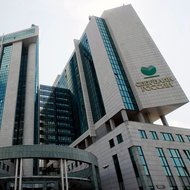MOSCOW — Igor A. Samarsky of the southern Russian city of Krasnodar gets fuel economy on his 1998 Lada sedan that would make a Prius owner green with environmental envy.
For all of 120 rubles — about $3.80, or a little more than a gallon of regular unleaded fuel in the United States — he can drive 140 miles. The Toyota hybrid would need three gallons of gas to drive that distance.
The only drawback in Mr. Samarsky’s mind is his wife’s lingering fear that the car, which runs on methane gas, will explode on the way to the grocery store. “My wife was afraid, but I didn’t mind,” Mr. Samarsky, a mechanic, said of the methane fuel kit he installed himself by placing a high-compression tank in the trunk and a hose snaking to the engine.
“She said, ‘I won’t drive this car, it will blow up.’ But then she saw the savings, and she calmed down.”
Gazprom, the state-owned energy monopoly better known for heating houses and powering factories in Europe, is making a bet that natural gas cars are an alluring market for future growth, at home in Russia and in other European countries that have bought its gas. All the ingredients are in place for adoption of natural gas vehicles in Russia, the world’s second-largest gas producer after the United States, with economic and environmental payoffs.
Economically, it’s no contest at the pump compared with gasoline because natural gas, whose main component is methane, is so abundant and cheap in Russia. It costs about $2 a gallon less than gasoline. (For such comparisons, compressed gas is measured by its cost for a volume containing the same amount of energy as a gallon of gasoline.)
Lax regulations in Russia have already provided a foothold for natural gas for cars. Even before the auto industry officially joined in, do-it-yourself kits were readily available. Unlike the hybrids and plug-ins produced by brand-name automobile companies, many of the natural gas cars in Russia are aftermarket conversions. In Russia, a complete system can be bought for less than $1,000 at a roadside repair shop in parts of the country where natural gas is commonly used, like the region around Krasnodar.
Natural gas fuel systems in the United States, in contrast, are handled with extraordinary care. High standards are set for the tanks of compressed gas.
An advocacy group, Natural Gas Vehicles for America, estimates certified aftermarket kits are available for about 40 models of cars and trucks and cost $12,000 to $18,000. Four factory-equipped natural gas and dual-fuel cars are for sale in the United States today: the Honda Civic NG, the Dodge Ram 2500, the Chevy Silverado and the Ford F-250.
Long-haul truckers, fleet car operators and railways are adopting methane, Dave McCurdy, president of the American Gas Association, said in a telephone interview.
In Russia, natural gas has been adopted by lower-income and rural drivers, along with farmers and operators of light-duty trucks, said Yevgeny N. Pronin, director of the National Gas Motor Association of Russia, and also an executive at Gazprom in charge of marketing gas for transportation.
Gazprom, though, would like to see wider adoption. A large Russian carmaker, Russian Machines, this year announced a policy, endorsed by Gazprom, to include natural gas systems as standard on buses and light utility trucks, like the Gazelle.
The Russian government and Gazprom, though, are just now pressing aggressively for a switch to natural gas at home, where prices are about tied with the United States as the lowest in the world.
The wholesale price for natural gas at the Henry Hub in Louisiana, a standard contract for gas in the United States, was $3.33 per million British thermal units in February; the government-set domestic natural gas tariff in Russia this year is expected to average $3.87 for the same quantity.
This is about one-quarter of the wholesale price of natural gas in other industrialized countries, like Britain or Germany, according to a study of Russia’s gas market released by Bank of America Merrill Lynch in February, meaning vehicle owners in Russia and the United States have the most to gain from converting to natural gas from gasoline or diesel.
The biggest issue in Russia, as it will be in any country that tries a conversion, is where drivers can refuel.
In both the United States and Russian conversions, a dashboard switch allows a driver to choose the fuel type, and most drivers keep their gasoline tanks filled as a reserve.
Article source: http://www.nytimes.com/2013/04/12/business/energy-environment/russia-skips-hybrids-in-push-for-natural-gas-cars.html?partner=rss&emc=rss
